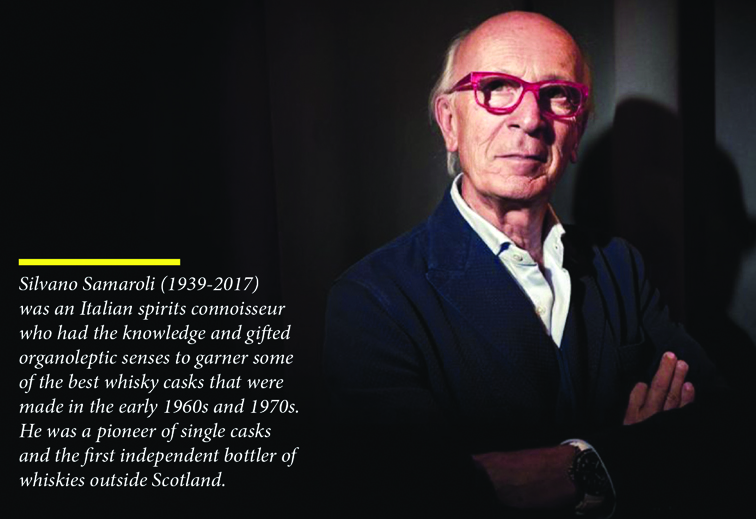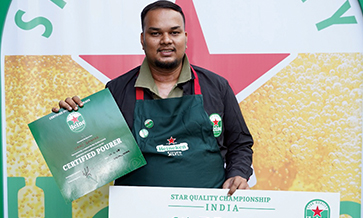The quest for the best is a basic human instinct: Man often takes pride in having acquired, seen, tasted and conquered the best of the best. As in fine arts or even sports, in the realm of spirits and wines too the debate on the best rages in many a conversation.
Whisky has been universally recognised as the uncontested champion drink and has been accepted culturally and intellectually across the globe. Having been exalting for more than 25 years in whiskies, and having come across experts, aficionados, geeks and a few with extreme knowledge and fine taste, I can safely vouch that there are no whiskies that come close to the taste of some Samaroli bottlings.
In fact, some say whisky people are divided into two categories: those who have tasted a Bowmore 1966 Bouquet and Laphroaig 1967 Samaroli, and those who have not!
Silvano Samaroli (1939-2017) was an Italian spirits connoisseur who had the knowledge and gifted organoleptic senses to garner some of the best whisky casks that were made in the early 1960s and ’70s. He was a pioneer of single casks and the first independent bottler of whiskies outside Scotland.
Let us talk about three of the best from his repertoire, and why they are considered the best whiskies ever made. As we always compare the superlatives, it would be worthwhile to relate each whisky to the most aesthetically appealing pleasures of mankind: paintings, music and cinema.

Ladies and Gentlemen, let me declare the three best whiskies ever made:
- Bowmore 18-YO, 1966/1984, (53% ABV), Samaroli Bouquet, 720 bottles
- Laphroaig 15-YO, 1967/1982, (57% ABV), R.W Duthie & Co, Samaroli Sherry cask, 720 bottles
- Ord 22-YO, 1962-1984, (58% ABV), Samaroli Bouquet, 720 bottles.
Bowmore Samaroli Bouquet
You approach this with utmost reverence and humility. I wonder if the 25 years of 2,500 malt-mileage is enough to judge this giant. Well, pour it in to the brandy goblet anyway and let’s see. Hold it with both hands and turn to the direction of Islay and bow your head. Start swirling the goblet to mask all apprehensions.
On the nose, asafoetida!! This takes me back 17 years to Antwerp, to Luc Timmermans’s house. For the first time in my tasting of whiskies, you find this Indian spice in a whisky. A Bowmore 40-YO, 1966-06 (43.4% ABV), Duncan & Taylor, Peerless, Cask #3316. Maybe the old 1966 Bowmores have this common feature! Beautiful whisks of half-burnt smoke (from wet palm leaves), sweet peat and a myriad of tropical fruits.
The flavours come out like a gentle, indulgent genie escaping from Aladdin’s magic lamp. Ripe melons, apricots, perfectly ripened Chausa mangoes, old moist tobacco, leather, old notebooks and whatnot. Its time to give it some rest and swirl.
Next, you get minerals and an interplay of sweet smoke and asafoetida (hing), intoxicating sweets smells of all tropical fruits (especially jackfruit) entering and exiting like the mysterious characters in Akira Kurosawa’s Rashomon. You don’t know what the next scene is going to be.
On the palate, umami!! The Japanese get this from seaweed; but for me, when the hing goes into cooking, the acrid flavours turn into umami in the dish. A swirl on the palate becomes honey-like and takes me back to Serge’s place in Turckheim, savouring the delicious Chateau d’Yquems. Chewy and sweetly savoury – what a mouth feel and oomph!
The flavours on the nose come back on the palate like the sfumato in Mona Lisa or go back and forth like Goldberg variations of Bach. When you talk about them, you talk about theme, harmony, feel and the way these masterpieces appeal to you. Mona Lisa and Goldberg Variations are live pieces of art, and so is the Bowmore Bouquet – it speaks to you!
Finish? It never does! Final stanza of Wordsworth’s Daffodils reverberates in the mind. So which league does it belong to: Mona Lisa (Leonardo Da Vinci), Goldberg Variations (Johann Sebastian Bach), or Rashomon (Akira Kurosawa)? 98 Points.
Laphroaig Samaroli Sherry Cask
Perhaps the highest-rated whisky on the site ‘www.whiskybase.com’ among the 2.21 lakh whiskies they rated! As I am already under oath to Islay, I don’t need to bow my head again!
R.W. Duthie is owned by Wm Cadenhead and in all practicality we can safely say that these are Cadenhead’s casks handled by R.W. Duthie in favour of Samaroli.
On the nose, it is funky, sweet medicinal iodine. You feel as though you are in some hospital corridor! I know infinite complexities are going on there, but one distinct note takes me back to my school days: fountain pen ink! Moss, herbaceous and all kinds of rich, dark heavy-stoned fruits.
Unlike the Bowmore, where the pre-dominant fruits are tropical, these are rich fruits and berries. Thick pomegranate syrup and smoked candied bacon on the sidewalks in Singapore Chinese bazaar. Sometimes earthy, like you’re walking on a wet forest floor. What does it need to make this kind of whisky? There seems to be no end to the superlatives; they come and go in hoards.
On the palate it is pure nectar. A concoction of umami blends of thick beef broth and smoked ham, followed by the most luxurious Christmas cake that has ever been baked.
Raisins, dates, figs and dried prunes, all soaked in rich brandy followed by all kinds of oriental spices like nutmeg, mace, cloves and cinnamon, with interludes of mild phenols hitting at the back of the nose.
The ‘malt-orgasms’ (plagiarised word from Serge) keep on coming endlessly. This is a mesmerising and mystic painting, like The Starry Night that plays a choral symphony on the palate.
The finish is unending. Surrealistic, like Inspector Deckard in The Blade Runner and Roy Batty’s soliloquy “…. I watched C-Beams glitter in the dark over Tannhauser gate”.
The Starry Night (Vincent van Gogh), Ode to Joy (Ludwig van Beethoven), or The Blade Runner (Ridley Scott)? 98 Points.
Ord Samaroli Bouquet
Ord, Glen Ord, Ordie, Muir of Ord and, currently, The Singleton of Glen Ord, are all the same – situated a few miles away from Inverness. For many whisky experts this one may not make it as one of the top whiskies, but in my list, it certainly ranks as one of the five in my all-time favourites.
Herbaceous on the nose. It is like Himalayan blue poppy that smells earthy and citrus. After some time, you get intoxicating sweet smells of frangipani and that of night queen. This has loads of OBE (old bottle effect).
On the non-floral front, there are loads of tropical and sub-tropical fruits made into a mixed fruit jam. More citrus and some malty notes accompanied strangely, by faint hints of smoke and sweet peat. Did they do floor maltings then at Glen Ord or were they direct-fired stills? I don’t know.
After giving a fair amount of air to the glass, you get all those old characteristics of moist tobacco, musty notebooks and furniture polish.
On the palate, lots of beeswax, giving a feeling of fullness. Now all those fruits on the nose come back on the palate with an orchestration of fruit cocktails. The spirit appeals to you with a warmth and gentle innocence that is yet complex like the four carnivalesque characters in Aranyer Din Ratri, or the flower power in Monet’s floral paintings.
Loads of sub-tropical fruits like apricots, peaches and plums. After some time the sub-tropical fruits give way to real tropical fruits like ripe Alphonso mangoes, melons and candied oranges. This Ord is an oxymoron, it’s not ordinary.
The finish is an honest and gentle fruit bomb, yet with complexities. It plunges you into a catharsis akin to listening to Thyagaraja’s “sogasuga mrudanaga thalamu…”
Floral paintings of Claude Monet, Sogasuga Mrudanga Thalamu (Thyagaraja), or Aranyer Din Ratri (Satyajit Ray)? 96 Points.
(Sample courtesy: Bowmore and Laphroaig by Arun Prashant of The Swan Song, Singapore. Ord 1962 by Max Righi, Whisky Antique S.R.L, Italy)














